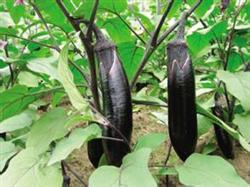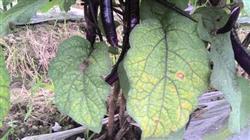High-yield cultivation techniques of eggplant in early spring in open field

1. Varieties with good commodity quality, strong cold resistance and disease resistance, high and stable yield, low light tolerance, suitable for dense planting and excellent quality, such as Hangqi No.1 and Yinqi No.1, etc. 2, seedling and cultivation methods Open field eggplant generally use improved Yangqi electric hot line seedlings, sowing seedlings in late January, planting in late April, harvest in late June. 3, seeding seedlings 3.1, seed treatment: 1~2 days before soaking seeds, then soak in 1% potassium permanganate solution for 30 minutes, remove and wash clean. Then soak the seeds in warm water of 50 - 55 DEG C, which is 5 - 6 times the volume of the seeds, for 10 - 15 minutes, stir continuously, soak for 8 - 10 hours when the temperature is reduced to about 30 DEG C, take out and rub the mucus on the surface of the seeds with fine sand, wrap the treated seeds with wet cloth, and germinate at about 30 DEG C. During germination, it is washed with clean water once a day, and it can germinate in 5~7 days. Sow seeds when more than 70% of the seeds are white. 3.2 Pre-sowing preparation: 60% fertile paddy soil not planted with solanaceous vegetables and 40% pig manure mixed evenly as culture soil, plus appropriate ternary compound fertilizer and 25% Want to know more vegetable experts and friends? Carbendazim 1 liang. Then make seedbed, bed width 1.2 meters, when necessary, spread geothermal line 80~100 watts per mu, and then spread 10 cm thick nutrient soil on it, pour water to prepare for sowing. 3.3 Sowing: Sowing is carried out in the morning of a sunny day. The sprouting seeds are evenly scattered on the ridge surface, covered with nutrient soil 1 cm thick and covered with plastic film. Before emergence, the temperature should be kept at 25℃~30℃ in the day, 16℃~20℃ at night, and the ground temperature should be about 20℃. Generally, the seedlings can be fully produced in 5~6 days, and the plastic film should be removed after 70% emergence. 3.4 Seedling management: after the seedlings are complete, the room temperature is appropriately lowered, 20℃~25℃ during the day and 15℃ at night, and dry nutrient soil is sprinkled once to the seedbed to prevent the cap from emerging, and the two cotyledons are completely spread, and the thickness is 0.3~0.5 cm each time. When the seedlings grow to two leaves and one heart, they are divided into seedlings. The method is to open small grooves in 10~15 cm row spacing, water in the grooves, arrange them according to 10 cm plant spacing, and then cover nutrient soil. After seedling separation, strengthen heat preservation, 28℃~30℃ in daytime. 16℃~20℃ at night. When the heart leaves of seedlings begin to grow, the temperature should be controlled at 20℃~25℃ during the day and 13℃~15℃ at night to prevent excessive growth. About 10 days before planting, seedlings were tempered at about 20℃ in the day and 12℃ at night. 4. Planting: before planting, apply 5000 kg of decomposed organic fertilizer and 50 kg of multi-component compound fertilizer in combination with soil preparation, plant in sunny days, irrigate enough water in ditches, and plant seedlings after water infiltration. Plant spacing 30~35 cm, planting 2500~3000 plants per mu, covering soil later. 5. Field management 5.1 intertill: shallow intertill 3 days after planting to improve ground temperature and promote slow seedling. 5.2 Fertilizer and water management: generally do not water after slow seedling to before flowering, such as drought can be watered a small water. To the door eggplant "stare" period can be topdressing watering, combined with watering mu urea 10~15 kg, potassium sulfate 10 kg. When eggplant fruit, every 5~7 days irrigation water, can be every 3 days after a fertilizer, each mu of urea 10~15 kg. 5.3 Trimming and branching: After six eggplant sit, keep two bifurcated branches, and remove the axillary buds under the door eggplant. 6, pest control is the main disease gray mold, available 5% Sukeling WP 1500 times solution; or 75% chlorothalonil WP 600 times solution, every 7-10 days once, continuous control 2-3 times, at the same time should also pay attention to the prevention and control of viral diseases. The main pests are aphids and thrips, which can be controlled with 10% good winter 1000 times solution or 20% aphixing EC 800 times solution, and 73% promite EC 2000 times solution.
- Prev

Eggplant planted in greenhouse should pay attention to light and temperature and make good use of water
Eggplant likes temperature and is not resistant to cold, and suitable "microclimate" conditions are required for eggplant planting in greenhouse, the suitable room temperature for seed germination is 25-30 ℃, the low temperature is 11-18 ℃, and the suitable temperature for flower bud differentiation at seedling stage is 20-25 ℃ in daytime and 15-20 ℃ at night. In the range of suitable temperature, if the temperature is lower, the flower bud differentiation is delayed, but the long flower.
- Next

How to control the withering of chili and eggplant
Eggplant magnesium deficiency first of all to find out what symptoms eggplant magnesium deficiency is generally characterized by the lower leaves chlorosis yellowing, leaf veins remain green, sometimes accompanied by orange, purplish red and other colors. The difference between magnesium deficiency and potassium deficiency is that magnesium deficiency chlorosis tends to yellowing or albinism; the difference with physiological senescence leaves is that magnesium deficiency veins do not fade.
Related
- Where is it suitable to grow horseradish in China? it is expected to see the middle altitude horseradish in Alishan.
- How to prevent tomato virus disease reasonably? (Control methods included)
- Many people like to plant towel gourd on the balcony. What are the main points of this method and management?
- What crops can chili peppers be mixed with?
- Fertilization techniques and matters needing attention in Tomato
- What are the grafting techniques for peach seedlings in spring?
- Harm and control methods of root swelling disease of Chinese cabbage
- What are the pests of sweet potatoes? How to prevent and cure it?
- Symptoms, causes and Control methods of navel Rot in Tomato
- The cause of "Cucumber rotten bibcock" in Farmers' planting Cucumber and its Control Plan

